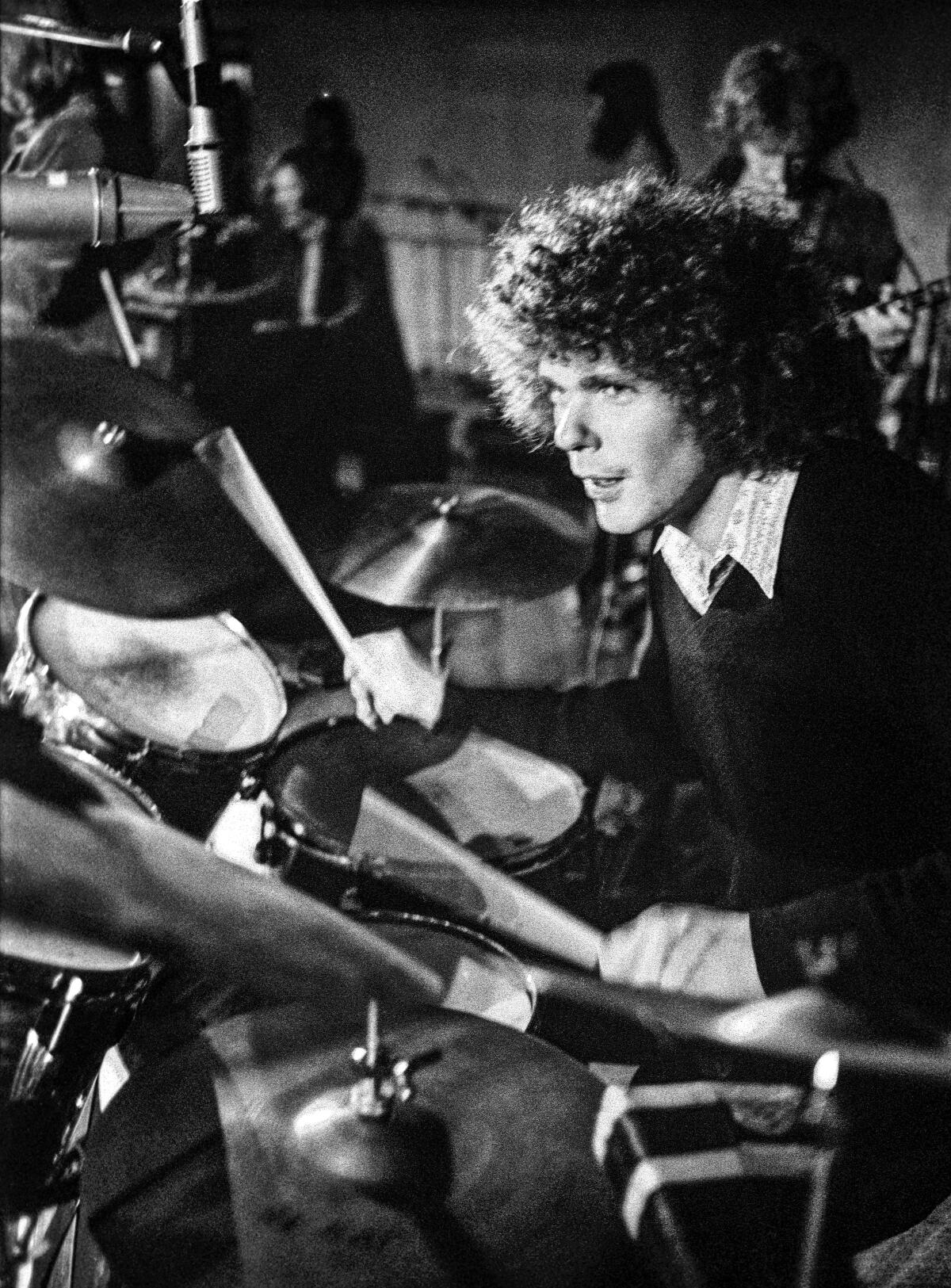A harrowing look at drummer Jim Gordon’s descent from rock talent to convicted murderer

- Share via
Book Review
Drums & Demons: The Tragic Journey of Jim Gordon
By Joel Selvin
Diversion Books: 288 pages, $29
If you buy books linked on our site, The Times may earn a commission from Bookshop.org, whose fees support independent bookstores.
The year was 1970, and Jim Gordon was in rock ‘n’ roll heaven.
The drummer was a part of Joe Cocker’s infamous Mad Dogs and Englishmen revue, a traveling circus of sex, drugs and legendary music, featuring bandleader and keyboardist-guitarist Leon Russell; saxophonist Bobby Keys, a sideman for the Rolling Stones; and singer Rita Coolidge. The bacchanalian troupe astonished audiences with their transcendent performances, leaving fans wanting more.
For Gordon, not yet 25, the moment was particularly sweet. A well-known session musician whose inventive percussion helped propel songs by the Beach Boys, the Byrds, Paul Revere and the Raiders and Glen Campbell to the top of the charts, he relished stepping out of the studio’s shadows onto a larger stage. Gordon would go on to play drums for Eric Clapton’s Derek and the Dominos, adding the song’s indelible piano coda to “Layla,” and record with John Lennon and George Harrison. Clapton and Ringo Starr considered him the best drummer in rock.
But beneath the sunshine, storm clouds lurked.
Before releasing new memoir “Down With the System” on May 14, Tankian spoke about why he’s optimistic about Armenia, and whether we might see another album from System of a Down.
One night after a Mad Dogs and Englishmen show, Gordon was hanging out in a hotel room with his girlfriend Coolidge and bassist Carl Radle, his future Derek and the Dominos bandmate. After drinking and snorting coke, Gordon asked Coolidge if he could speak to her in the hall. Given how close they had become, she thought he might propose. Instead, he punched her in the face, knocking her unconscious.
Mad Dogs and Englishmen members chalked up Gordon’s erratic behavior to the craziness surrounding the tour. But there was more to it. “For Jim, it was a crack in the mask he wore,” writes Joel Selvin, the former San Francisco Chronicle music critic, in his deeply reported and well-written book “Drums & Demons: The Tragic Journey of Jim Gordon.” “His herculean self-control had failed him, letting the dark forces he had kept under tight wraps peek out, dark forces that would have shocked anyone who knew sunny Jim.”
As recounted by Selvin, Gordon heard voices that would only grow more hostile and dangerous over time, even causing him intense physical pain if he dared to disobey them. Years later, Gordon would commit one of the most horrific acts in the annals of rock history: On June 3, 1983, he murdered his 71-year-old mother by bludgeoning her with a hammer and stabbing her repeatedly in the chest. Gordon said her voice had ordered him to commit the grisly act.
Gordon died in 2023 at 77 after nearly four decades in prison, still haunted by voices, still harboring resentment toward his long-deceased mother for her “controlling” behavior.
In “Drums & Demons,” Selvin aims to restore Gordon’s humanity and reputation by showing his professional triumphs in the context of his struggles with addiction and mental illness.
This year saw the formation of a new supergroup: books broke news about Madonna, Sly Stone, Lou Reed, Ella Fitzgerald, Barbra Streisand and even Bob Dylan.
Selvin largely succeeds by adding flesh, blood and soul to the Gordon story. He does an especially nice job of capturing the optimism and creative explosion of the Southern California pop scene in the 1960s and Gordon’s role in it. Selvin shows the handsome, blond, 6-foot, 4-inch drummer in the studio playing on Brian Wilson’s masterpiece “Good Vibrations” and driving the beat of a 24-piece orchestra on the Mason Williams 1968 instrumental hit “Classical Gas.”
In one memorable scene, producer Richard Perry tapped Gordon to play drums on Carly Simon’s “You’re So Vain” after two other drummers failed to give him the sound he wanted. “The drum kit was an extension of his being, and he danced all over it,” Selvin writes. Gordon “made the track sound like a big, juicy hit record on the first take, and at the end of the evening, he left no doubt in the minds of everyone in the room that was exactly what they now had.”
Selvin vividly charts Gordon’s decline in harrowing detail, including his alarming violence toward women, myriad psychotic episodes and banishment from rock royalty because of his increasing unreliability and frightening behavior. In the months before murdering his mother, for instance, a bloated, dull-eyed Gordon had been reduced to playing four sets a night for $30 with a faceless outfit called the Blue Monkeys in a gritty Santa Monica bar. The voices in his head continued to torment him.
The biggest problem with the book is that despite Selvin’s laudable efforts to make Gordon whole, the drummer just wasn’t that interesting, especially compared with the artists he worked with.
“Jim moved through life like a ghost. He was friendly, but he had no friends,” Selvin writes. “He hid himself from close observation. His smile served him; it kept him safe and unchallenged. Nobody really knew him.”
That this is such a strong book reflects Selvin’s prodigious journalistic talents. The author of more than 20 works including “Altamont,” which chronicles the ill-fated 1969 rock festival headed by the Stones, he is one of the best rock writers out there. Still, I’m not convinced that session-man Gordon merits a 250-page biography. John Bonham, the thundering soul of Led Zeppelin, certainly does. So too does Starr, the heartbeat of the Beatles. But Jim Gordon? Perhaps a long magazine piece.
Ballon, a former Times and Forbes reporter, teaches an advanced writing class at USC. He lives in Fullerton.
More to Read
Sign up for our Book Club newsletter
Get the latest news, events and more from the Los Angeles Times Book Club, and help us get L.A. reading and talking.
You may occasionally receive promotional content from the Los Angeles Times.









